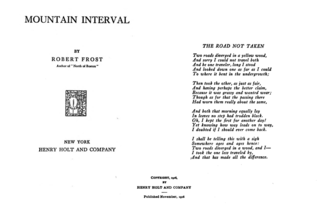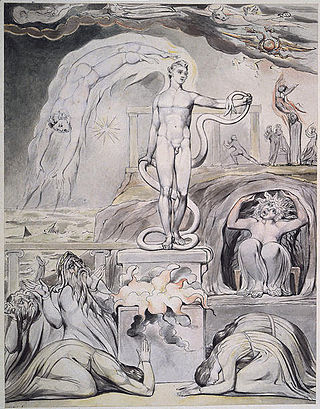In poetry, metre or meter is the basic rhythmic structure of a verse or lines in verse. Many traditional verse forms prescribe a specific verse metre, or a certain set of metres alternating in a particular order. The study and the actual use of metres and forms of versification are both known as prosody.

Poetry, also called verse, is a form of literature that uses aesthetic and often rhythmic qualities of language − such as phonaesthetics, sound symbolism, and metre − to evoke meanings in addition to, or in place of, a prosaic ostensible meaning. A poem is a literary composition, written by a poet, using this principle.
A quatrain is a type of stanza, or a complete poem, consisting of four lines.
Poetry analysis is the process of investigating a poem's form, content, structural semiotics and history in an informed way, with the aim of heightening one's own and others' understanding and appreciation of the work.
The Spenserian stanza is a fixed verse form invented by Edmund Spenser for his epic poem The Faerie Queene (1590–96). Each stanza contains nine lines in total: eight lines in iambic pentameter followed by a single 'alexandrine' line in iambic hexameter. The rhyme scheme of these lines is ABABBCBCC.
An anapaest is a metrical foot used in formal poetry. In classical quantitative meters it consists of two short syllables followed by a long one; in accentual stress meters it consists of two unstressed syllables followed by one stressed syllable. It may be seen as a reversed dactyl. This word comes from the Greek ἀνάπαιστος, anápaistos, literally "struck back" and in a poetic context "a dactyl reversed".
An iamb or iambus is a metrical foot used in various types of poetry. Originally the term referred to one of the feet of the quantitative meter of classical Greek prosody: a short syllable followed by a long syllable. This terminology was adopted in the description of accentual-syllabic verse in English, where it refers to a foot comprising an unstressed syllable followed by a stressed syllable. Thus a Latin word like íbī, because of its short-long rhythm, is considered by Latin scholars to be an iamb, but because it has a stress on the first syllable, in modern linguistics it is considered to be a trochee.
Rhyme royal is a rhyming stanza form that was introduced to English poetry by Geoffrey Chaucer. The form enjoyed significant success in the fifteenth century and into the sixteenth century. It has had a more subdued but continuing influence on English verse in more recent centuries.
Terza rima is a rhyming verse form, in which the poem, or each poem-section, consists of tercets with an interlocking three-line rhyme scheme: The last word of the second line in one tercet provides the rhyme for the first and third lines in the tercet that follows. The poem or poem-section may have any number of lines, but it ends with either a single line or a couplet, which repeats the rhyme of the middle line of the previous tercet.
Iambic pentameter is a type of metric line used in traditional English poetry and verse drama. The term describes the rhythm, or meter, established by the words in that line; rhythm is measured in small groups of syllables called "feet". "Iambic" refers to the type of foot used, here the iamb, which in English indicates an unstressed syllable followed by a stressed syllable. "Pentameter" indicates a line of five "feet".

"The Road Not Taken" is a narrative poem by Robert Frost, first published in the August 1915 issue of the Atlantic Monthly, and later published as the first poem in the collection Mountain Interval of 1916. Its central theme is the divergence of paths, both literally and figuratively, although its interpretation is noted for being complex and potentially divergent.
"Andrea del Sarto" is a poem by Robert Browning (1812–1889) published in his 1855 poetry collection, Men and Women. It is a dramatic monologue, a form of poetry for which he is famous, about the Italian painter Andrea del Sarto.
"Stopping by Woods on a Snowy Evening" is a poem by Robert Frost, written in 1922, and published in 1923 in his New Hampshire volume. Imagery, personification, and repetition are prominent in the work. In a letter to Louis Untermeyer, Frost called it "my best bid for remembrance".
This is a glossary of poetry.

"A Prayer for my Daughter" is a poem by William Butler Yeats written in 1919 and published in 1921 as part of Yeats' collection Michael Robartes and the Dancer. It is written to Anne, his daughter with Georgie Hyde Lees, whom Yeats married after his last marriage proposal to Maud Gonne was rejected in 1916. Yeats composed the poem while staying in a tower at Thoor Ballylee during the Anglo-Irish War, two days after Anne's birth on 26 February 1919. The poem reflects Yeats's complicated views on Irish Nationalism, sexuality, and is considered an important work of Modernist poetry.
The following outline is provided as an overview of and introduction to poetry:
"Acquainted with the Night" is a poem by Robert Frost. It first appeared in the Autumn, 1928 issue of The Virginia Quarterly Review and was republished that year in his collection West-Running Brook.

On the Morning of Christ's Nativity is a nativity ode written by John Milton in 1629 and published in his Poems of Mr. John Milton (1645). The poem describes Christ's Incarnation and his overthrow of earthly and pagan powers. The poem also connects the Incarnation with Christ's Crucifixion.
Latin prosody is the study of Latin poetry and its laws of meter. The following article provides an overview of those laws as practised by Latin poets in the late Roman Republic and early Roman Empire, with verses by Catullus, Horace, Virgil and Ovid as models. Except for the early Saturnian poetry, which may have been accentual, Latin poets borrowed all their verse forms from the Greeks, despite significant differences between the two languages.
Poetic devices are a form of literary device used in poetry. Poems are created out of poetic devices composite of: structural, grammatical, rhythmic, metrical, verbal, and visual elements. They are essential tools that a poet uses to create rhythm, enhance a poem's meaning, or intensify a mood or feeling.



